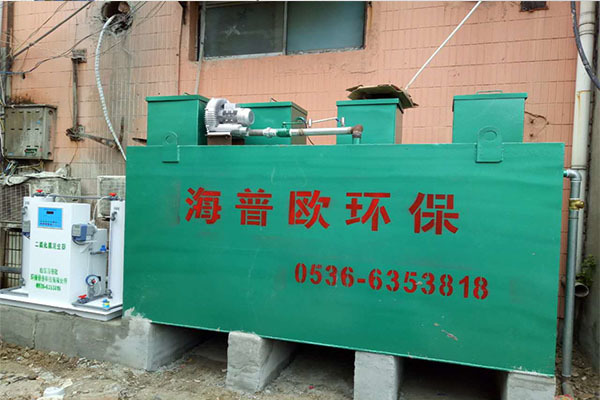News details
Hospital Sewage Treatment Equipment: Pricing, Influencing Factors, and Procurement Recommendations
Release time:
2025-10-20 14:33
Hospital sewage contains special pollutants such as pathogens, pharmaceutical residues, and heavy metals. Its treatment must strictly comply with the Discharge Standard of Water Pollutants for Medical Institutions (GB 18466-2005). The price of sewage treatment equipment is one of the core considerations in hospital procurement decisions. This article will provide professional and practical information for hospital procurement personnel from three aspects: key influencing factors of equipment prices, price references in different scenarios, and scientific selection suggestions, helping to reasonably control costs while ensuring compliance with treatment standards.
I. Core Influencing Factors of Hospital Sewage Treatment Equipment Prices
The price of sewage treatment equipment is not fixed; it is affected by factors such as the hospital’s actual needs, process selection, and configuration standards. Specifically, these factors can be divided into the following 5 categories:
-
Treatment Scale (Core Variable): The price is directly linked to the sewage treatment volume, which is determined by the number of hospital beds. For example, small hospitals with fewer than 100 beds generate an average daily sewage volume of approximately 50-100 m³ and require small-scale equipment. In contrast, large hospitals with more than 500 beds may produce 500-1000 m³ of sewage per day, necessitating large-scale complete sets of equipment. The price gap between these two types of equipment can exceed 10 times.
-
Treatment Process (Technical Cost): Different pollutants require different treatment processes, leading to significant cost differences. Conventional general hospitals mostly adopt the "pretreatment + biological treatment (AO/MBR) + disinfection" process. Due to its advantages of high-quality effluent and small footprint, the MBR process is 30%-50% more expensive than the traditional AO process. Infectious disease hospitals need to add "advanced disinfection + detoxification" modules, which increases the cost of a single set of equipment by an additional RMB 50,000-150,000.
-
Discharge Standards (Compliance Cost): If a hospital is located in a sensitive area (e.g., near a drinking water source), it must meet stricter discharge standards (e.g., COD ≤ 50 mg/L, total residual chlorine ≤ 0.5 mg/L). This requires the addition of advanced treatment units (such as activated carbon adsorption and membrane filtration), increasing the overall equipment cost by 20%-30%. Equipment that meets regular standards has relatively lower costs.
-
Equipment Configuration and Materials: The materials and configuration of core components directly affect the price. For instance, 304 stainless steel, used for sewage-contacting tank bodies, has stronger corrosion resistance than carbon steel but costs 15%-25% more. Equipping the system with an automatic control system (e.g., online monitoring of COD and flow) enables unattended operation but adds RMB 30,000-80,000 to the equipment cost.
-
Manufacturer Services (Hidden Costs): Formal manufacturers provide one-stop services including "design + installation + commissioning + after-sales operation and maintenance," and some even offer a 1-3 year warranty. Such services are reflected in the quotation, which is usually 10%-15% higher than quotations for equipment-only sales. However, these services help avoid additional expenses in subsequent operation and maintenance.
-

II. Price References for Hospital Sewage Treatment Equipment in Different Scenarios
Based on the current market situation (2025), the price ranges of sewage treatment equipment for hospitals of different sizes and types are as follows (Note: Prices include basic installation and commissioning, excluding civil engineering, pipeline networks, and subsequent chemical costs):
-
Small Hospitals (fewer than 100 beds, average daily water volume 50-100 m³): Integrated sewage treatment equipment is mostly used, with the "pretreatment + AO + chlorine dioxide disinfection" process as the mainstay. The equipment price ranges from RMB 80,000 to 200,000. If upgrading to the MBR process is required, the price increases to RMB 150,000-300,000.
-
Medium-sized Hospitals (100-500 beds, average daily water volume 100-500 m³): Complete sets of equipment are needed (including grilles, equalization tanks, biological reaction tanks, sedimentation tanks, and disinfection equipment). The price for regular processes ranges from RMB 300,000 to 800,000. For medium-sized infectious disease hospitals, the addition of advanced treatment modules raises the price range to RMB 500,000-1,200,000.
-
Large Hospitals (more than 500 beds, average daily water volume ≥ 500 m³): Customized large-scale complete systems are required, usually constructed in phases. These systems include four major units: pretreatment, biological treatment, advanced treatment, and sludge treatment. The total equipment price for conventional general hospitals ranges from RMB 1,000,000 to 3,000,000. For Grade III Class A hospitals or specialized infectious disease hospitals, due to higher treatment standards and larger scales, the price can reach RMB 2,000,000-5,000,000.
It should be noted that the above prices are mainstream market reference prices. Affected by raw material prices (e.g., stainless steel, chemicals) and regional labor costs, there may be a 5%-10% price difference between northern and southern regions. In addition, government procurement projects or bulk purchases can reduce costs by 5%-15% through negotiation.
III. Scientific Recommendations for Hospital Sewage Treatment Equipment Procurement (Balancing Cost and Compliance)
When procuring equipment, focus should not be limited to the initial price. Instead, a comprehensive assessment should consider long-term operation and maintenance costs as well as compliance requirements to avoid the problem of "low-cost procurement but high-cost operation and maintenance." Specific recommendations are as follows:
-
Clarify Needs First, Then Determine Equipment Scale: Based on the number of hospital beds, outpatient volume, and whether there are infectious disease departments, calculate the accurate average daily sewage volume and types of pollutants (e.g., whether high-concentration pharmaceutical residues are present). This avoids situations where the equipment is "oversized" (wasting costs) or "undersized" (failing to meet treatment standards).
-
Prioritize Compliance, Then Control Costs: It is essential to ensure that the equipment’s treatment capacity meets the requirements of local environmental protection departments. Priority should be given to manufacturers with "Environmental Protection Product Certification" and "ISO 9001 Quality Certification" to avoid purchasing unqualified equipment that may lead to subsequent penalties and additional costs.
-
Compare "Whole-Life Cycle Costs": In addition to the initial equipment price, attention should be paid to the equipment’s energy consumption (e.g., fan and water pump power), chemical consumption (e.g., chlorine dioxide, PAC), and maintenance frequency (e.g., membrane module replacement cycle). For example, although MBR equipment has a higher initial price, its operation and maintenance costs are 15%-20% lower than those of traditional processes, making it more cost-effective in the long run.
-
Verify Manufacturer Cases and After-Sales Services: Select manufacturers with more than 3 project cases in hospitals of the same scale. Request confirmation of after-sales response time (e.g., on-site service within 24 hours) and clarify the scope of free services during the warranty period (e.g., component replacement, technical support) to reduce risks in subsequent operation and maintenance.
Conclusion
The price of hospital sewage treatment equipment is the result of balancing "needs and costs," with the core principle of "selecting equipment based on needs, prioritizing compliance, and considering long-term benefits." When procuring equipment, hospitals should first clarify their treatment scale and discharge standards, then conduct a comprehensive evaluation based on process characteristics, equipment configuration, and manufacturer services—rather than simply pursuing low prices. Reasonable equipment investment not only ensures that sewage discharge meets standards but also reduces long-term operation and maintenance costs, providing guarantee for the sustainable operation of hospitals.










